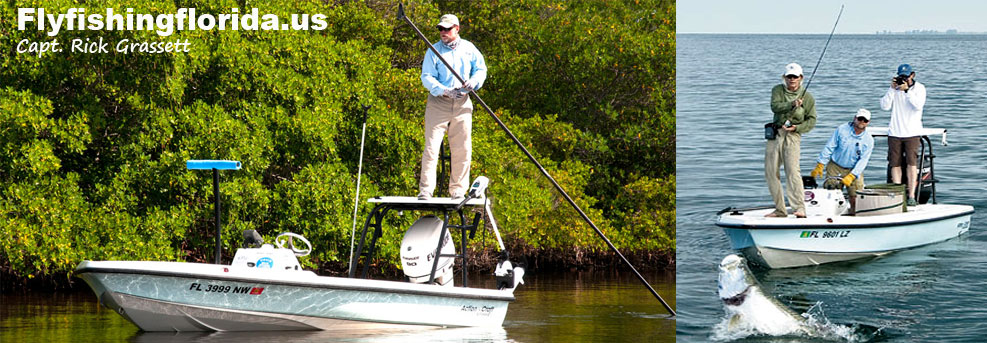Monthly Fishing Forecast
Capt. Rick Grassett’s Sarasota, FL Fishing Forecast for December 2025
You may find reds along with big trout concentrated in potholes, along the edges of bars and flats or tailing on shallow grass flats on negative low tides this month. This is a good month for snook action around lighted docks in the ICW. Some lights will also have trout and reds making it possible to get a dock “slam”. There may also be good action in the coastal gulf with false albacore (little tunny), Spanish mackerel and tripletail, depending on conditions.
You might find reds in potholes or along the edges of flats and bars on negative low tides. They may also tail on shallow grass when the tide is low. CAL jigs with shad tails and 4” jerk worms, DOA Shrimp and lightly weighted flies with weed guards will work well in that situation. As the tide rises, reds will spread out and feed on shallow flats. I usually let the stage of the tide tell me where to look for reds. When it is low they may be found in potholes or on the outer edges of shallow flats, moving closer to the shoreline as the tide rises. You may also find them around docks this month.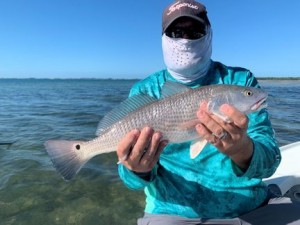
Catch and release snook fishing around lighted docks can be good in December. Larger baitfish will thin out and snook will feed on glass minnows in the ICW at night. I like docks that have a good tidal flow and deep water under them. You may also find reds and trout in dock lights during December. CAL jigs with shad tails and jerk worms, DOA Tiny TerrorEyz and DOA Shrimp are my favorite lures for snook at night. Fly anglers should do well with sink tip fly lines and small white flies. Tide is important for dock fishing, think of the tide as a conveyor belt moving food towards fish.
You may also find big trout in skinny water this month in many of the same areas where you find reds. The same lures and techniques that I use for reds will also work for trout in the same areas. I feel that it’s important to protect large trout, which are usually female breeders. Full regulations and details can be viewed at https://myfwc.com/ .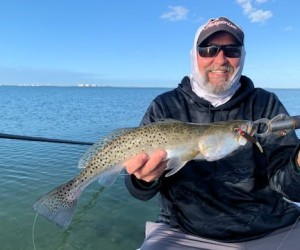
Flounder prefer a mix of sand and grass, so they may be found in sandy areas in potholes or on the edges of bars in December. I like to fish a heavier CAL jig in potholes, bouncing or dragging it along the bottom in potholes. They fight well due to their body shape, round and flat.
You should also find trout on deep grass flats this month along with blues, Spanish mackerel or pompano. Blues and mackerel may sometimes feed on the surface, so bird activity may give their presence away. Pompano may skip when you drift or run past them and when that happens, circle back upwind and drift through the area casting ahead of your drift. I like to drift and cast ahead of my drift with CAL jigs and a variety of plastic tails or DOA Deadly Combos. Fly anglers should score with sink tip fly lines and weighted flies like Clousers, which behaves more like a jig.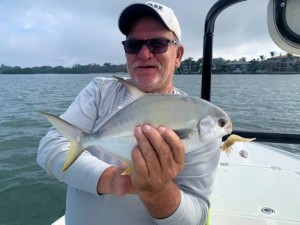
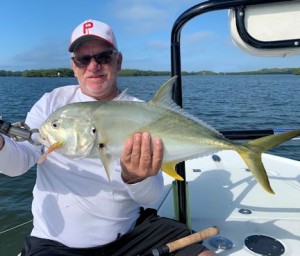
There should still be some action in the coastal gulf with Spanish mackerel, blues, false albacore and tripletail. Rough or cold water later in the month may slow the action and move fish south or offshore. Look for terns either diving or hovering low over the surface of the water to find albies, blues and mackerel feeding on the surface. Once you’ve found them, cast top water plugs or CAL jigs with 3” shad tails to catch them. Fly anglers should score with glass minnow fly patterns, poppers or Crease flies. Sometimes top water plugs or fly poppers will draw fish to the surface or from a distance especially over structure. You’ll need to add wire or heavy fluorocarbon to your leader when blues and mackerel are around. Look for tripletail around crab trap floats or channel markers. Once you’ve located a fish, work back into the wind or current with an electric trolling motor to get into casting range and cast a DOA shrimp, a weedless-rigged CAL shad tail or lightly weighted fly with a weed guard to them. Try to make your first shot count since they are much tougher to catch once they know you’re there.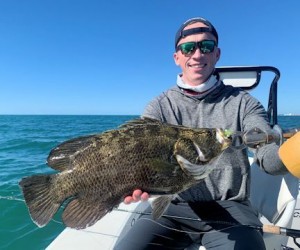
There will be lots of options in December. When fishing flats, I usually let conditions and the stage of the tide determine when, where and what I will target. I like to fish the coastal gulf for false albacore and tripletail whenever conditions are good. Our natural resources are under constant pressure from red tides fueled by agricultural, industrial and residential runoff, toxic spills and discharges, freezes, increasing fishing pressure and habitat loss and degradation, please limit your kill, don’t kill your limit!
Tight Lines,
Capt. Rick Grassett
FFI Certified Fly Casting Instructor
Fly Casting Instructor at CB’s Saltwater Outfitters,
Orvis Outfitter of the Year-2011
Hosted Destination Fly Fishing Trips
www.snookfin-addict.com and www.flyfishingflorida.us
E-mail snookfin@aol.com
(941) 923-7799 (Land line/no text)
